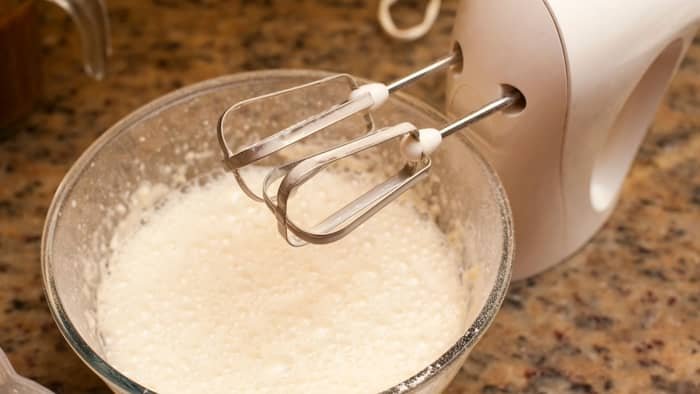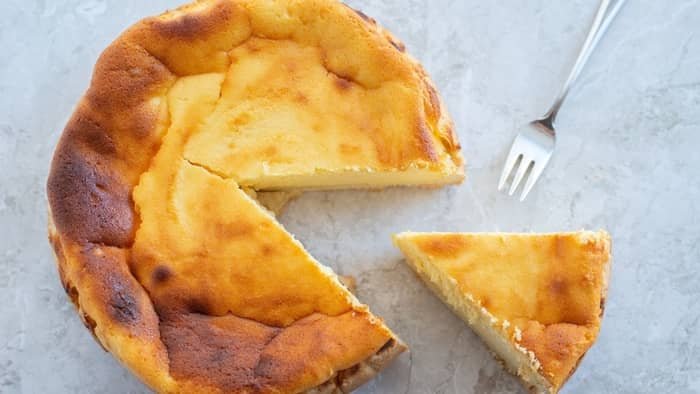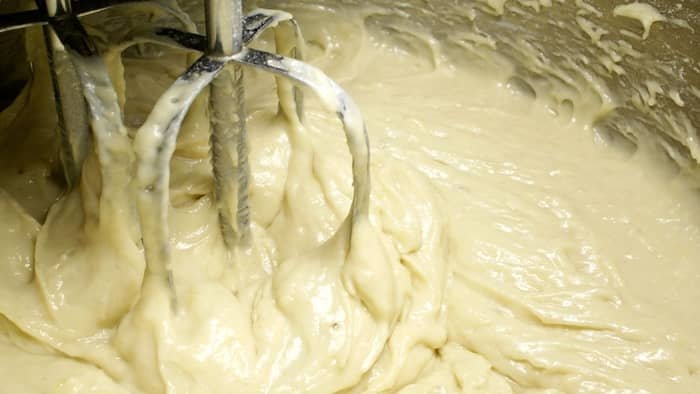By Lindy Van Schalkwyk, last updated on February 1, 2022
It’s frustrating when your cheesecake cracks or has a rubbery texture. But, did you know it could be because you overmixed cheesecake batter?
Believe it or not, but sudden temperature changes aren’t the only reason cheesecakes crack and flop. The second, not so often talked about, mistake people make is overmixing their cheesecake batter. Today, we will look at some ways you can prevent it and whether it is possible to fix it.
Overmixed Cheesecake Batter – Why Is It A Problem?
“Overmixing” is a term we see a lot in the baking world. And yet, people still don’t seem to fully grasp why it is such a bad thing, or worse, how to avoid it! So, today, we will break it down for you.
When you work with batters, or any baked item really, you are trying to create a very specific structure. For breads, you want an elastic dough that will create an open crumb. For souffle, you want an airy texture that will hold up on its own.
And, a big part of creating this structure is the mixing method you use. That is why you will often see egg whites being whipped separately before being incorporated into the batter. This whipped product helps incorporate air to give the baked item a soft and fluffy texture.
So, for cheesecakes specifically, generally they have pretty dense structures. But, dense doesn’t mean rubbery. Many types of cheesecakes use creaming methods and whipping techniques to incorporate air. So, while the texture is dense, it still has that melt-in-your-mouth feel to it.
But, here is where the problem comes in. Once you have overmixed cheesecake batter, that airiness is either lost or too much air is added. This changes the structure you should have (or have created) and ultimately, will change the final texture of your baked or unbaked cheesecake.

How a Cheesecake is Made
Ideally, the following method is used to make your average cheesecake. First, the cream cheese is whipped until it becomes light and fluffy. If there is butter in the recipe, the butter is also creamed along with it.
Next, the sugar is added and the mixture is further creamed. Now, you add your whole eggs one at a time. Sometimes you only add egg yolks and incorporate the whipped egg whites later.
After the egg yolks have been incorporated, any aerated product (whipped cream or whipped egg whites) is gently folded in.
How To Tell If Cheesecake Is Overmixed And What Happens
There are a few things that can happen when you overmix a cheesecake batter. Exactly which of these apply to your situation mainly depends on the cheesecake recipe you have used and the degree to which you overmixed the batter.
Cracks form Because you’ve Added too Much air
The first and most likely thing to happen is that you are incorporating too much air into your cheesecake batter. While you may think this will produce an uber fluffy airy cheesecake, you are wrong.
You know those dreaded canyons that seem to form out of nowhere? Well, cheesecake cracks are very commonly caused by an overmixed batter. What happens is that when air is incorporated into a batter and baked, the air pockets expand and give a lift (and an airy texture) to the cake.
But, if too much air is added, it makes the cheesecake rise a lot. And, unfortunately, the cake doesn’t have the structural support (aka flour) to hold the lift. The cheesecake sinks in and eventually cracks.

The Mixture Falls flat and Makes a Dense Cheesecake
This can happen before you have even baked the cheesecake. It again has to do with the air that you are incorporating. But, instead of the cake falling flat during the baking process, the batter falls flat immediately when mixed.
The cheesecake batter will fall flat when too much air is incorporated and there is no structural support. This makes the batter very dense and will produce a rubbery cake texture all around. Now, this problem is different from the above-mentioned one as a rubbery batter won’t necessarily cause a crack in the cheesecake itself. You will only realize your mistake once you take a bite.
Another reason your mixture may fall flat is because you completely deflate the airiness. By overmixing it, you are breaking the bonds that the whipped cream or egg whites have created. Once broken, the mixture falls flat and gives you the same rubbery texture.
The Mixture Separates
The final problem that may occur when you have overmixed cheesecake batter is that the mixture completely separates. When you are mixing ingredients together, you are creating an emulsion.

When you overmix the batter, the emulsion could break and make the ingredients (especially the fat and liquid ones) separate from each other.
The mixture will separate before you have baked the cheesecake. Trust us, you will immediately see this happening. You cannot bake a cheesecake whose batter has separated. To say it would be a disaster is an understatement!
How To Fix Overmixed Cheesecake Mistakes
Unfortunately, once you have overmixed cheesecake batter (and especially after it has been baked and cracked) there isn’t much you can do to “fix” it. The best fix is to prevent doing t entirely.
Use Room Temperature Ingredients
A common reason for overmixed cheesecake batter is that the ingredients did not want to blend together well. This is mainly because they were used at different temperatures. So, if you ever make cheesecake again, make sure all of your ingredients are at room temperature and softened (butter, cream cheese, etc.).
By literally only applying this step, you are already well on your way to prevent overmixing your cheesecake batter entirely!
Do not Over Mix
Now, this may seem like a redundant thing to say. But, it is really as simple as that. To correctly mix your ingredients together, always stop when they have just been fully incorporated together.
Don’t keep mixing to “make sure they are well distributed”. They are! If you cannot see any distinguishable dry or liquid ingredient, you have mixed the batter enough.
The same goes for folding in ingredients. You can mix one-third of the whipped ingredient into the batter. Then, start gently folding in the second third. Before it is fully incorporated, add the final third and fold until you just have a uniform batter.
Overmixed Cheesecake Batter – Conclusion
If you have found this article incredibly helpful, let us know in the comments below. As you can now see, it is easy to avoid overmixing cheesecake batter and now knowing exactly how to do so, you will never have a flopped cheesecake again!

Lindy Van Schalkwyk is a culinary specialist with a background in Advanced Cooking, Advanced Pâtisserie, Media Communications and Nutrition. She has gained invaluable experience in the culinary industry having worked in some of the top restaurants in Africa in 2016 and 2017. Her expertise in nutrition has enabled her to develop recipes for special dietary needs. In 2018, Lindy began working in the Food Media industry, focusing on recipe development, recipe writing, food writing and food styling.

